
METAX
Meta tokenized stock (xStock)
| تریدر | نوع سیگنال | حد سود/ضرر | زمان انتشار | مشاهده پیام |
|---|---|---|---|---|
 Audacity618Sıralama: 214 | خرید | حد سود: تعیین نشده حد ضرر: تعیین نشده | 10.11.2025 | |
 ShortSeller76Sıralama: 38 | خرید | حد سود: تعیین نشده حد ضرر: تعیین نشده | 04.11.2025 | |
 isahebdadiSıralama: 859 | خرید | حد سود: تعیین نشده حد ضرر: تعیین نشده | 09.11.2025 | |
GoldenZoneFXSıralama: 1763 | خرید | حد سود: تعیین نشده حد ضرر: تعیین نشده | 11.11.2025 | |
 ben_findlaySıralama: 2773 | خرید | حد سود: تعیین نشده حد ضرر: تعیین نشده | 13.11.2025 |
Meta tokenized stock (xStock) Fiyat Grafiği
سود Üç Ay :
سیگنالهای Meta tokenized stock (xStock)
filtre
Mesajı şuna göre sırala
Tüccar Türü
timeframe
چگونه در بازار پرنوسان، طلا را به پناهگاه امن پول خود تبدیل کنیم؟
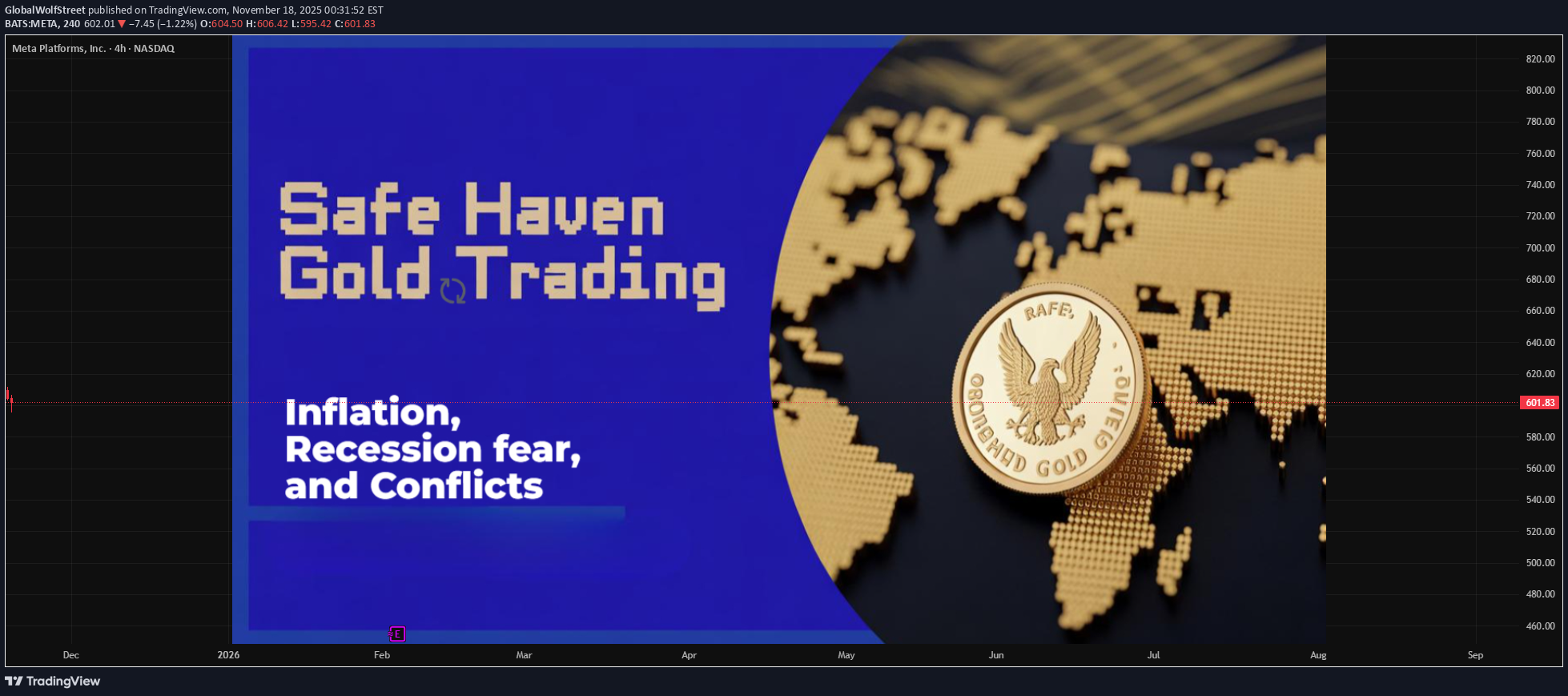
1. Why Gold Is Considered a Safe-Haven Asset Gold is perceived as a safe-haven for several reasons: 1.1 Intrinsic Value Gold is a physical asset with limited supply. It cannot be printed like fiat currency, and mining output grows slowly over time. This scarcity gives gold long-term value stability. 1.2 Universal Acceptance Gold is accepted globally as a store of value by governments, central banks, banks, institutions, and retail investors. It is one of the few assets that retain value regardless of the political or economic system in place. 1.3 Hedge Against Inflation & Currency Depreciation When inflation rises or a currency weakens—especially the USD—gold prices tend to increase. This is because investors shift capital into assets that preserve purchasing power. 1.4 Geopolitical Crisis Shield During wars, conflicts, sanctions, or major political uncertainty, gold attracts strong demand. Institutions rotate out of risk assets like equities and into safer stores of value. 1.5 Negative Real-Yield Environment When real interest rates (interest rate minus inflation) fall or turn negative, the opportunity cost of holding non-yielding gold decreases, making it more attractive. 2. What Are Safe-Haven Assets? Safe-haven assets are those that retain or increase value during times of market volatility, economic crisis, or geopolitical stress. The key safe-haven categories include: Gold US Dollar (USD) US Treasury bonds Japanese Yen (JPY) Swiss Franc (CHF) Silver and other precious metals Sometimes: utilities, consumer staples, defensive stocks Gold remains the most universal and liquid among them. 3. Key Drivers of Gold Prices To trade gold effectively, traders must understand the main price drivers: 3.1 US Dollar Index (DXY) Gold is priced in USD globally. A stronger USD → gold becomes expensive for holders of other currencies → gold falls A weaker USD → gold becomes cheaper globally → gold rises This inverse relationship is one of the strongest correlations in global markets. 3.2 Interest Rates (Especially US Treasury Yields) Gold does not pay interest. When yields rise, gold becomes less attractive. Rising yields → bearish for gold Falling yields → bullish for gold Real yields matter more than nominal yields. 3.3 Inflation Gold is a traditional inflation hedge. Higher inflation → gold demand increases → gold prices rise Low/deflation → gold weakens 3.4 Geopolitical & Financial Risks Gold spikes during: wars banking system stress sovereign debt crises market meltdowns oil price shocks trade wars currency crises Gold thrives when uncertainty rises. 3.5 Central Bank Gold Purchases Many central banks buy gold to diversify reserves away from the USD. Large purchases by China, India, Russia, and emerging markets support gold prices. 3.6 ETF Flows Gold-backed ETFs (like SPDR Gold Trust – GLD) influence prices through physical purchasing. 4. Gold Trading Instruments 4.1 Spot Gold (XAU/USD) The most traded instrument in gold markets. XAU/USD represents gold priced in U.S. dollars. 4.2 Gold Futures (COMEX) Highly liquid and used by institutional investors and hedgers. 4.3 Gold ETFs (GLD, IAU) Useful for passive investors or those who want gold exposure without physical storage. 4.4 Gold Mining Stocks Companies like Barrick Gold, Newmont etc. Mining stocks are leveraged plays on gold prices. 4.5 Physical Gold (Bars, Coins) Used mostly for long-term wealth preservation. 5. Safe-Haven Flow Dynamics Understanding how capital flows during crises is key. 5.1 Risk-Off Environment When market fear rises: Equities fall Bond yields drop USD and gold rise Gold attracts capital as a non-correlated asset. 5.2 Risk-On Environment When markets recover: Equities rise USD strengthens Gold often consolidates or corrects Safe-haven demand decreases. 6. Trading Strategies for Gold & Safe-Haven Assets 6.1 Trend Following Strategy Since gold often moves in strong directional trends: Use moving averages (50/200 EMA) Buy when price is above key MAs and forming higher highs Sell when price breaks below MAs with strong volume 6.2 Breakout Strategy Gold reacts strongly to breakouts from: price consolidation zones triangle patterns wedge patterns horizontal ranges A breakout with high volume can signal a strong move. 6.3 Mean Reversion (Contrarian) Strategy Gold frequently retraces after sharp moves. Indicators: RSI (overbought/oversold) Bollinger bands Price divergence Use cautiously during trending markets. 6.4 Macro-Based Trading Use fundamental triggers: Fed interest rate decisions CPI inflation releases NFP jobs report Geopolitical events Central bank speeches These can cause rapid volatility in gold. 6.5 Safe-Haven Correlation Trading You can trade gold relative to: DXY movements US 10-year yield changes JPY or CHF moves VIX index spikes When volatility rises, gold usually rallies. 7. Gold in Portfolio Diversification Gold is one of the best hedges against: inflation currency weakness economic slowdowns stock market crashes Historically, gold has low correlation with equities, making it ideal for diversification. Portfolio strategies: 5–10% gold allocation for stability 15–20% during high inflation periods Use gold to hedge global macro risks 8. Risks in Gold Trading Despite being a safe-haven, gold trading carries risks: 8.1 High Volatility Gold can move sharply around: CPI NFP Fed meetings geopolitical headlines 8.2 Interest Rate Shocks An unexpected spike in yields can cause large downside in gold. 8.3 USD Strength A strong, sudden USD rally can drag gold lower. 8.4 False Breakouts Gold sees many fake breakouts due to liquidity-driven algorithmic trading. 8.5 Over-leveraging Leverage in futures or CFDs can magnify losses during volatile phases. 9. Long-Term Outlook for Gold Over decades, gold generally trends upward due to: global inflation rising debt levels currency debasement central bank gold accumulation geopolitical risks The long-term picture remains bullish, but short-term volatility is normal. Conclusion Gold and other safe-haven assets play a critical role in global financial markets, serving as stabilizers during periods of uncertainty and volatility. Gold remains the most trusted safe-haven due to its intrinsic value, global acceptance, and strong historical performance during crises. Understanding the correlations between gold, interest rates, USD, inflation, and market sentiment enables traders to anticipate market movements and trade profitably. Whether using technical setups, macro analysis, or multi-asset safe-haven flows, gold trading offers opportunities for both short-term traders and long-term investors. However, managing risk, avoiding over-leverage, and monitoring global macro signals are essential for success in gold markets.

Elliottwave-Forecast
تحلیل تکنیکال متا (META): آیا ریزش ادامه دارد یا زمان جهش فرا رسیده است؟
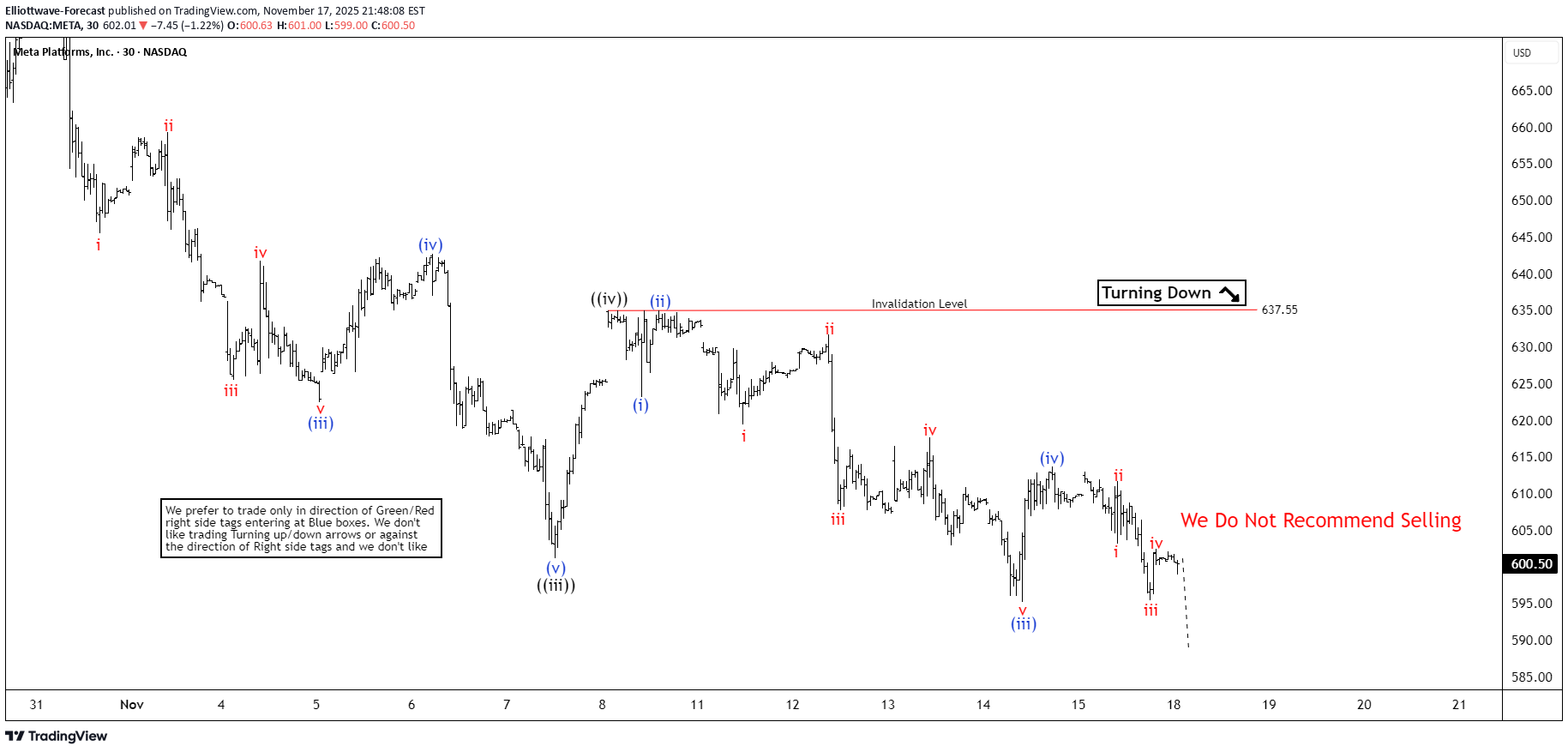
META için kısa vadeli Elliott Dalgası görünümü, 29 Ekim'in en yüksek seviyesinden başlayan döngünün devam ettiğini ve beş dalgalı bir dürtüsel yapı olarak ortaya çıktığını gösteriyor. 29 Ekim zirvesinden itibaren dalga ((i)) 650,17 dolarda sona erdi. Bunu ((ii)) dalgasında düzeltici bir yükseliş izledi ve 680,96 dolarda sona erdi. Daha sonra hisse senedi ((iii)) dalgasında düşüş göstererek 601,20 $'a ulaştı. Daha sonra ((iv)) dalgasındaki toparlanma, 30 dakikalık grafikte gösterildiği gibi 637,55 dolarda sona erdi. Şu anda dalga ((v)) daha düşük dereceli bir itici güç olarak ortaya çıkıyor gibi görünüyor. Bu yapı içerisinde dalga (i) 623,23 dolarda tamamlandı ve dalga (ii)'deki kısa yükseliş 635 dolarda sona erdi. Düşüş, dalga (iii)'de yeniden başladı ve 595,20 dolara kadar düştü. Bunu, dalga (iv)'de 613,68 dolarda sonuçlanan mütevazı bir toparlanma izledi. Son bacak olan dalga (v) daha aşağıya doğru uzanmalı, böylece dalga ((v)) ve 29 Ekim'in en yüksek seviyesinden daha geniş döngü tamamlanmalıdır. Bu beş dalga dizisinin tamamlanmasının ardından, 29 Ekim zirvesindeki düşüşün izini sürmek için minimum üç dalgalı bir düzeltici ralli gerçekleşmelidir. Yakın vadede, 637,55 dolarlık pivot sağlam kaldığı sürece hisse senedi, dalganın ((v)) sonlandırılması ve mevcut düşüş döngüsünün tamamlanması için marjinal yeni bir düşük potansiyelini koruyor

ForexClinik
متای متا در آستانه خط روند حیاتی: آیا صعود ادامه مییابد؟
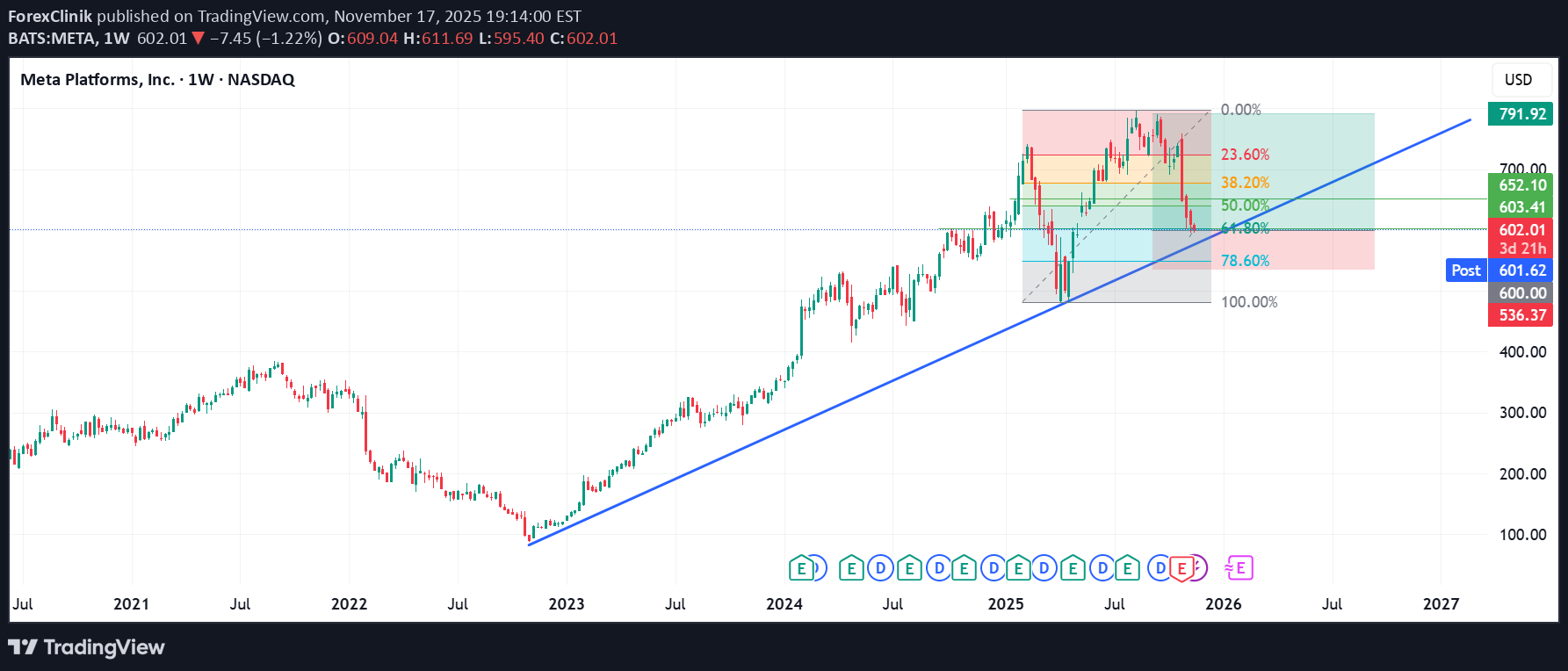
META önemli bir teknik bölgeye yaklaşıyor. Şu anda odaklanılan trend çizgisi 31 Ekim 2022'de ortaya çıktı ve zaman içinde geçerliliğini korudu. Aynı trend çizgisi bu yılın nisan ayında iki kez yeniden test edildi ve fiyat hareketi, tüm zamanların en yüksek seviyesine ulaştıktan sonra bir kez daha bu çizgiye doğru ilerliyor. Şu anda varlık, geri dönüşlerin sıklıkla meydana geldiği iyi bilinen bir bölge olan Fibonacci %61,8 geri çekilme seviyesinde bulunuyor. Bu yapıya bağlı olarak varlık, mevcut bölgeden yukarı doğru move başlayabilir veya yükselen trend çizgisini yeniden test etmek için 10-20 dolar daha düşebilir. Bu geri çekilme sırasında META'daki ilk pozisyonlarımı aldım ve fiyat trend çizgisine ulaşırsa riskimi artırabilirim. Genel olarak görünümüm hala yükselişte. Sorumlu bir şekilde ticaret yapın. Giriş: RR 1:3 Güven: Yüksek
نوسانات بازار: چگونه ریسکهای ژئوپلیتیک، اقتصاد و سرمایهگذاری شما را شوکه میکنند؟

1. Fundamental Causes of Market Volatility Market volatility arises from several core factors that disrupt stability and confidence. 1.1 Economic Data and Macroeconomic Indicators Markets constantly react to economic data such as GDP growth, inflation, manufacturing output, unemployment rates, and consumer spending. Positive data boosts confidence, reducing volatility. Weak or unexpected data increases uncertainty, causing price swings. Inflation reports, for example, can shift expectations regarding central bank actions, leading to sharp moves in equities, bonds, and currencies. 1.2 Central Bank Policies Interest rate decisions by central banks (like the Federal Reserve, ECB, RBI) are among the biggest volatility triggers. Rate hikes generally cause volatility by increasing borrowing costs and reducing liquidity. Rate cuts often create volatility by signaling economic weakness. Even a single statement by a central bank official can shift market expectations and fuel strong price movements. 1.3 Market Liquidity Conditions Liquidity refers to how easily market participants can buy or sell assets: High liquidity → smooth price movements, low volatility. Low liquidity → sharp price gaps and increased volatility. During crises, liquidity often dries up as investors pull back, amplifying price swings. 1.4 Corporate Earnings and Forecasts Public companies report quarterly results, which influence investor sentiment: Better-than-expected earnings reduce volatility. Weak results or negative forecasts raise uncertainty. Technology stocks, high-growth sectors, and newly listed companies often experience large swings during earnings seasons. 1.5 Market Sentiment and Behavioral Factors Human emotions—fear, greed, uncertainty, panic—play a major role in volatility. Fear pushes investors toward selling or safe-haven assets. Greed leads to speculative buying. This psychological component is particularly strong in crypto markets and high-beta stocks. 2. How Geopolitical Risk Drives Market Volatility Geopolitical risk refers to events related to politics, conflict, diplomacy, policy changes, or international relations that can affect global economic stability. These risks can significantly disrupt supply chains, trade agreements, financial flows, and investor confidence. Here are the major geopolitical factors that cause market volatility: 2.1 Wars, Armed Conflicts, and Military Tensions Conflicts—whether ongoing or unexpected—create massive uncertainty. Examples include tensions in the Middle East, Russia-Ukraine war, or border disputes. Impact on markets: Oil and energy prices spike when conflict affects major producers. Currency markets fluctuate as investors shift to safe-haven assets like USD, CHF, JPY, and gold. Stock markets fall, especially in affected regions. Defense sector stocks rise due to increased military spending. War-driven volatility stems from fears of economic disruption and global trade instability. 2.2 Trade Wars and Tariff Conflicts Modern economies are highly interconnected. When countries engage in trade retaliation—such as tariffs, sanctions, or import quotas—the global supply chain is disrupted. The US-China trade war is a clear example, where each announcement of tariffs triggered immediate market volatility. Trade wars cause: Rising production costs Lower corporate profits Declines in global trade volumes Inflationary pressures Supply chain disruptions As a result, equity markets often react sharply to escalating or easing trade tensions. 2.3 Political Instability and Government Changes Elections, coups, leadership changes, and instability within governments increase uncertainty for investors. Examples of events that create volatility: Contested elections Hung parliaments or coalition collapses Corruption scandals Policy reversal risks Unpredictable regulatory changes Political uncertainty directly affects: Currency performance Stock market confidence Foreign investment flows (FDI and FPI) Credit ratings and debt markets Investors prefer stability; any threat to that stability adds volatility. 2.4 Economic Sanctions and Diplomatic Standoffs Sanctions imposed on countries or companies can disrupt trade and global supply chains. When sanctions affect major exporters of oil, metals, technology, or food, the resulting shortages or price shifts ripple across global markets. Sanctions create volatility in: Energy prices Commodity markets Currency markets Logistics and shipping sectors Diplomatic tensions also delay trade agreements and investment decisions. 2.5 Global Health Crises and Pandemics As seen during COVID-19, global health emergencies can create unprecedented levels of volatility: Stock markets crash due to economic shutdowns Safe-haven assets rise sharply Supply chains break down Central banks deploy emergency measures Pandemics amplify geopolitical tensions as countries enforce travel bans, restrict exports, or compete for medical resources. 2.6 Energy and Commodity Supply Disruptions Energy is the backbone of global economic activity. Events that affect oil, gas, rare earth metals, agricultural commodities, or key resources lead to market instability. Examples: OPEC production cuts or disagreements Pipeline disruptions Embargoes on oil or gas Weather-related supply shocks Commodity price shocks spread quickly across economies, affecting inflation, currency value, corporate profits, and consumer spending. 2.7 Cyberattacks and Technological Warfare Cyberattacks targeting governments, financial systems, or critical infrastructure can shock markets instantly. These events raise fears about: National security Data breaches Disrupted financial transactions Losses for major corporations As countries invest more in cyber warfare, the risk becomes a permanent driver of market volatility. 3. Why Markets React Strongly to Geopolitical Events 3.1 Uncertainty Disrupts Forecasting Investors rely on predictable conditions to value assets. Geopolitical risks make economic outcomes uncertain, forcing investors to adjust expectations and rebalance portfolios. 3.2 Safe-Haven Flows Intensify Volatility During geopolitical stress: Gold, US Treasuries, and Swiss Franc rise. Risky assets like stocks and crypto fall. These rapid shifts create large price swings across markets. 3.3 Supply Chain Sensitivity Modern economies depend on complex, interconnected supply chains. Any geopolitical disruption can cause shortages, delays, and higher production costs—driving volatility. 4. Conclusion Market volatility and geopolitical risk are deeply interconnected. Volatility arises from macroeconomic factors, liquidity dynamics, central bank actions, and investor sentiment. But geopolitical risks—such as wars, elections, sanctions, cyberattacks, trade conflicts, and supply disruptions—intensify uncertainty and cause rapid market fluctuations. In today’s interconnected world, even a local political event can have global financial consequences. Understanding these risks helps investors, businesses, and governments prepare for unexpected market shifts, build resilient strategies, and effectively manage uncertainty.
افت شدید متا زیر 600 دلار: آیا سقوط بزرگتر در راه است؟

META Çok kısa kalıyorum. 600 doların altındaki reddedilme ideal değildi ancak dünyanın sonu da değil. Şimdilik, önümüzdeki haftalarda 600 dolarlık desteği kaybedeceğimiz ihtimali hâlâ yüksek.

Ejike_Odeh
سه مسیر ورود طلایی به سهام متا: فرصتهای انفجاری خرید قبل از ۲۰۲۶!
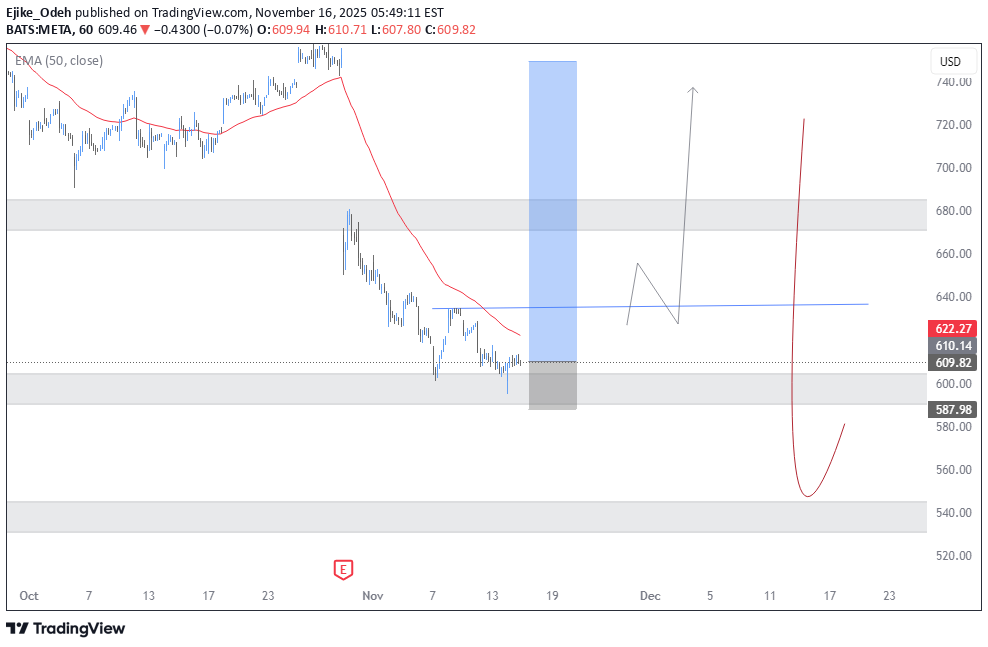
Meta için 3 olası giriş seçeneğim olmasına rağmen 1/2 giriş için %80'i tercih ediyorum Hisse senedi, önemli bir major talep bölgesine en son temas edene kadar aşağı yönde toparlanıyordu. Açık bir geri dönüşün sinyalini veriyor Yani yatırımcılar/swinger'lar 2026'da bankaya gitmek üzere
رمزگشایی سیاستهای بانک مرکزی: رازهای تجارت جهانی برای مبتدیان
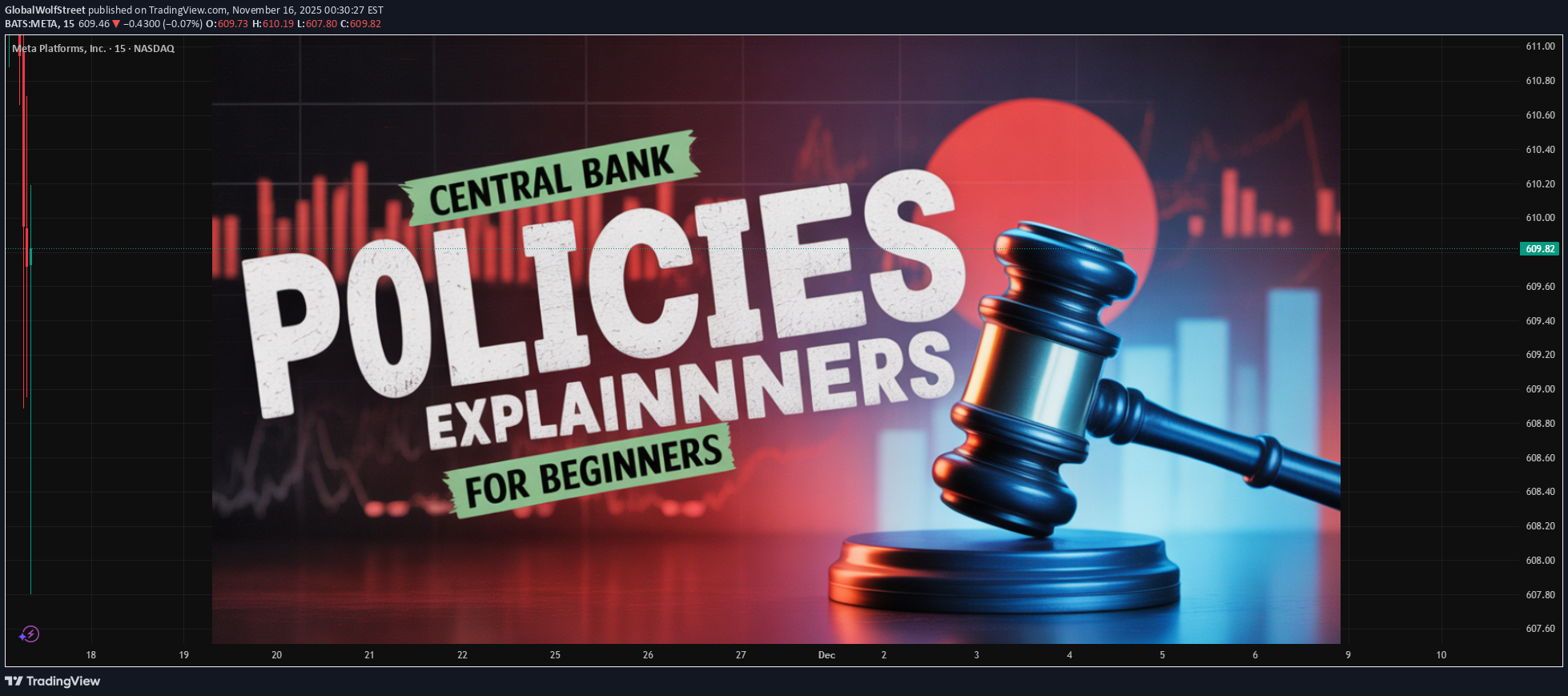
1. What Is a Central Bank? A central bank is a government-backed financial institution that manages a nation’s money supply, inflation, currency value, interest rates, and financial stability. Examples: Federal Reserve (USA) European Central Bank (ECB) Reserve Bank of India (RBI) Bank of Japan (BoJ) Bank of England (BoE) People’s Bank of China (PBoC) Central banks are not profit-making bodies. Their job is to maintain economic health, ensure stable currency, and create a predictable environment for businesses and international trade. 2. Why Central Banks Matter in Global Trade Global trade involves buying and selling goods/services across borders. Every trade transaction depends on: currency exchange rates, interest rates, credit availability, inflation levels, and economic stability. All of these variables are either controlled or influenced by central bank policies. For example: If the US Federal Reserve hikes interest rates → the US dollar strengthens → emerging markets face currency pressure → global commodities like gold and oil react immediately. If the RBI cuts interest rates → exports may become more competitive → imports become relatively expensive → affecting India’s trade balance. In short, central banks shape the macroeconomic environment in which international trade operates. 3. The Core Goals of Central Banks Central bank policies revolve around achieving major economic goals: a) Controlling Inflation High inflation weakens purchasing power and disrupts trade. Low inflation or deflation slows economic activity. Central banks aim for a moderate inflation level (usually 2%). b) Stabilizing the Currency A stable currency creates smooth international trade. Fluctuations can cause: export/import price shocks, higher hedging costs, volatility in forex markets. c) Managing Economic Growth Central banks cool the economy when it's overheated and support it during recessions. d) Ensuring Financial Stability They monitor banks, credit markets, and liquidity to avoid crises. 4. Key Central Bank Tools (Beginner-Friendly Breakdown) 1) Policy Interest Rates Interest rates are the most powerful tool. Central banks raise or cut the repo rate, federal funds rate, or benchmark rate to control the economy. When interest rates go UP: Loans become expensive. Businesses slow down expansion. Consumer spending declines. Currency strengthens. Imports become cheaper. Stock markets usually fall. Bond yields rise. When interest rates go DOWN: Loans become cheaper. Businesses borrow and expand. Consumer spending grows. Currency weakens. Exports become more competitive. Stock markets often rise. Gold and commodities gain. Interest rate decisions heavily affect global forex and equity markets, often leading to immediate volatility. 2) Open Market Operations (OMO) These are buying or selling government bonds to regulate liquidity. Buying bonds → injects money → increases liquidity Selling bonds → removes money → reduces liquidity OMOs are crucial during crises (like 2008 or COVID-19) to prevent market freezing. 3) Quantitative Easing (QE) QE is an advanced form of OMO. The central bank purchases large amounts of financial assets to pump liquidity into the economy. Effects: Lower long-term interest rates Higher stock prices Weaker currency Increased global capital flow into emerging markets Example: The Federal Reserve used QE in 2008 and 2020, sending global markets into strong bullish phases. 4) Foreign Exchange (FX) Intervention Central banks sometimes buy or sell their own currency to stabilize it. Example: RBI sells dollars to strengthen the rupee. Bank of Japan buys yen to prevent excessive weakness. Such interventions affect: import prices export competitiveness forex trading global capital flows 5) Reserve Requirements This is the percentage of deposits that banks must keep without lending. Higher reserve ratio → less lending → slower economy Lower reserve ratio → more lending → faster economy China’s PBoC frequently uses reserve requirement changes to manage its massive trade-driven economy. 5. How Central Bank Policies Impact the Global Trade Market 1) Currency Value and Exchange Rates Exchange rates directly influence global trade profitability. Example: Weak local currency → exports rise, imports fall Strong local currency → exports fall, imports rise Central bank policies are the number one driver of currency strength. Forex traders follow every speech, statement, and interest rate decision like a catalyst event. 2) Commodity Prices Most global commodities—oil, gold, copper—are priced in USD. When the Federal Reserve changes policy: USD strengthens → commodities fall USD weakens → commodities rise Central banks indirectly influence: international oil trade gold reserves management industrial metal pricing shipping and freight rates 3) Stock Markets Interest rate decisions immediately move global equities. Rate hikes cause downgrades in growth forecasts, hurting stock markets. Rate cuts encourage risk-on behavior, pushing equities higher. Emerging markets like India, Brazil, and Indonesia react strongly to US Fed and ECB policies due to foreign institutional investment (FII) inflows/outflows. 4) Global Capital Flows Capital moves across borders depending on interest rate differences. If US rates are high, global money flows back to the US, weakening emerging markets. If US rates fall, capital flows into Asia, boosting markets like India. Central banks shape these flows through rate decisions and liquidity tools. 5) Trade Balances A nation’s export–import performance changes with: currency valuation inflation levels credit availability interest rate environment Example: If RBI reduces rates → rupee weakens → Indian exports like textiles, IT services, and chemicals become more competitive. This shapes global supply chains. 6. How Traders Use Central Bank Signals Professional traders track every macro clue, such as: FOMC minutes RBI MPC meeting notes Inflation reports GDP forecasts Central bank speeches Market participants try to predict whether central banks will be: Hawkish (favor rate hikes) Dovish (favor rate cuts) This sentiment often moves markets even before the actual decision is taken. 7. Central Bank Policy Cycles Policies move in cycles depending on the economy: Tightening Cycle (Hawkish) Higher rates Reduced liquidity Strong currency Lower inflation Lower equity prices Easing Cycle (Dovish) Lower rates More liquidity Weaker currency Higher inflation risk Higher equity prices World trade flows change direction with each cycle. 8. Central Banks During a Crisis In crises, central banks: inject massive liquidity cut interest rates support banks stabilize currency buy government and corporate bonds This prevents: trade collapse credit freeze currency crashes COVID-19 is the best example: global central banks coordinated huge rate cuts and QE to revive world trade and markets. Conclusion Central bank policies act like the command center for global financial systems. Their decisions shape interest rates, inflation, currency strength, commodity prices, trading volumes, capital flows, and international trade dynamics. For beginners in the world trade market, understanding central bank behavior is essential because macro fundamentals drive long-term market trends. If you follow central bank statements and policy cycles closely, you will gain a powerful edge in forex trading, commodity analysis, equity market positioning, and global economic forecasting.
سقوط متا (META) زیر ۶۰۰ دلار: آیا کف ۵۰۰ دلاری بازار را حفظ میکند؟

Güncelleme META Beklendiği gibi 600 dolarlık destek seviyesini kaybettik. Boğaların 550-500 dolar bölgesinde dip yapmaya çalışmasını bekliyoruz. Bu tabanın tutunup tutunmayacağı daha geniş piyasaya bağlı olacaktır. Planım o bölgede kar elde etmek ve move ile bir sonraki işleme geçmek.
تأثیر هفتگی تجارت بر اقتصاد جهانی: از رشد تولید ناخالص داخلی تا نوسانات نرخ ارز

1. The Fundamentals of How Trade Affects Economics Trade affects economic performance through the principles of comparative advantage, resource specialization, and market efficiency. Nations produce goods for which they are most efficient and trade them for goods that others produce more efficiently. This specialization boosts productivity, lowers costs, and expands consumer choices. Trade influences economics through multiple channels: a. GDP Growth Exports contribute directly to a country’s gross domestic product (GDP). The more a nation exports high-value products, the faster its economy tends to grow. Weekly export orders, new shipping data, and port activity often give early signs of GDP trends. b. Employment and Industrial Development Trade expands industries that are competitive internationally. For example, countries with strong textile or automobile sectors benefit from higher employment, foreign investment, and supply-chain expansion. At the same time, weaker industries may contract if they cannot compete globally. c. Consumer Welfare Trade reduces prices, increases product variety, and improves quality due to global competition. Weekly changes in import costs—such as falling crude oil prices—can reduce inflation pressure in importing nations. d. Technological Transfer and Innovation Countries gain access to foreign technologies and advanced machinery via trade. Regular shifts in semiconductor, electronics, and machinery trade flows can influence domestic productivity. e. Currency Strength and Balance of Payments International trade impacts a nation’s currency value. A trade surplus strengthens the currency; a deficit weakens it. Weekly foreign exchange movements are closely tied to changes in import and export demand. 2. Weekly Dynamics: What Drives International Trade Movements? Weekly trade analysis observes short-term shifts that affect long-term economic trends. Several global factors influence trade every week: a. Commodity Price Movements Prices of crude oil, gold, natural gas, and agricultural goods often fluctuate weekly. Oil-importing countries benefit when crude prices fall, reducing inflation and supporting growth. Commodity-exporting countries—such as Brazil, Saudi Arabia, and Australia—see weekly revenue changes due to price volatility. b. Currency Exchange Rate Movements A stronger domestic currency makes imports cheaper and exports more expensive. For instance, if the Indian Rupee strengthens against the USD in a particular week, India may see cheaper imports of crude oil, electronics, and commodities. c. Supply Chain Disruptions Events such as port congestion, strikes, storms, or geopolitical tensions can cause weekly disruptions that affect global trade routes. The Red Sea, Suez Canal, and Taiwan Strait are common areas where disruptions impact trade flow. d. Trade Policies and Government Announcements Tariff changes, export restrictions, and free-trade agreements directly affect trade. Weekly policy updates from the US, EU, China, and India often move global markets. e. Global Demand Cycles A weekly slowdown in retail sales or industrial production in major economies—such as the US, China, Europe—can reduce demand for imports, influencing global prices and shipment volumes. 3. Weekly International Trade Analysis: What Typically Happens in a Week? A weekly trade overview helps understand real-time economic conditions. Here's how international trade patterns typically evolve in a week: a. Export and Import Data Releases Many countries release weekly trade metrics, including: cargo volumes port container movements shipping freight rates export order books commodity inventory levels These indicators show which industries are expanding or slowing. b. Shipping and Logistics Trends Weekly changes in: freight charges vessel availability port turnaround time affect trade costs. High freight rates usually slow trade; low rates encourage more shipments. c. Commodity Market Volatility Global commodity exchanges like NYMEX, LME, and ICE influence trade flows weekly. For example: A rise in metal prices boosts export revenue for miners. A fall in food grain prices affects agricultural exporters. d. Supply and Demand Imbalances Each week, new data about crop yields, factory output, or consumer demand shifts global trade flows. If China announces weak factory activity, metal and energy shipments fall globally. e. Global Trade Sentiment Market participants watch weekly events like: central bank speeches geopolitical developments economic data releases These influence the willingness to trade and invest across borders. 4. Impact on Emerging and Developed Economies Trade affects economies differently depending on their industrial structure, currency position, and dependence on imports. a. Developed Economies Countries such as the US, Germany, and Japan rely on: high-value exports (technology, automobiles) stable supply chains diversified trade partners Weekly trade data in these nations signals global economic direction. b. Emerging Economies Countries like India, Brazil, Indonesia, and Vietnam are more sensitive to: commodity price shifts currency fluctuations changes in global consumption Weekly export performance in textiles, chemicals, IT services, and agriculture significantly shapes economic conditions. c. Least Developed Economies These countries rely heavily on a few products (mining, agriculture). Weekly price shifts in commodities can greatly affect national revenue. 5. Trade Challenges Observed in Weekly Trends a. Protectionism Increasing tariffs and export controls from major economies create weekly uncertainty. b. Geopolitical Tensions Conflicts and sanctions disrupt weekly trade flows, affecting currencies and commodity prices. c. Supply Chain Vulnerabilities Still recovering from the pandemic, global logistics systems remain fragile. d. Inflation and Cost Pressures Rising freight costs or supply shortages can lead to weekly price fluctuations internationally. 6. Conclusion: Why Weekly Trade Analysis Matters for Economics International trade is a dynamic system that directly influences global economic health. Weekly fluctuations in shipping rates, commodity prices, policy announcements, and currency movements have both short-term and long-term impacts on national economies. These weekly movements help analysts forecast inflation, GDP growth, and investment sentiment. Understanding these patterns is essential for: investors businesses policymakers traders economic researchers In an interconnected world, weekly international trade developments provide early, real-time insights into economic direction, making trade one of the most critical components of modern economic analysis.

ben_findlay
سقوط سهام کوانتومی و فرصتهای خرید جدید: متا و پلاگ جذابترند!

Haftalar önce de belirtildiği gibi, piyasanın spekülatif kısmında perakende yatırımcılardan yoğun bir yatırım görüldü. QUBT, RR ve RGTI gibi aşırı değerli hisseler beklendiği gibi çökerken, büyük ilaç sektörü gibi temelde güçlü sektörler iyi durumda kaldı. Şortlarım tamamen bitti ve aşırı satılan META ve PLUG'u buradan satın alacağım. PLUG'ın spekülatif olmasına rağmen, bu kuantum çöpünün (QUBT) aksine temel değeri ve değeri vardır. META 610 için çağrı seçenekleri satın alma 16 Ocak 2026 Ayrıca aşağıdakiler için daha uzun tarihli arama seçeneklerini de tutuyorum: FİŞ ALMU FANG
Sorumluluk Reddi
Sahmeto'nun web sitesinde ve resmi iletişim kanallarında yer alan herhangi bir içerik ve materyal, kişisel görüşlerin ve analizlerin bir derlemesidir ve bağlayıcı değildir. Borsa ve kripto para piyasasına alım, satım, giriş veya çıkış için herhangi bir tavsiye oluşturmazlar. Ayrıca, web sitesinde ve kanallarda yer alan tüm haberler ve analizler, yalnızca resmi ve gayri resmi yerli ve yabancı kaynaklardan yeniden yayınlanan bilgilerdir ve söz konusu içeriğin kullanıcılarının materyallerin orijinalliğini ve doğruluğunu takip etmekten ve sağlamaktan sorumlu olduğu açıktır. Bu nedenle, sorumluluk reddedilirken, sermaye piyasası ve kripto para piyasasındaki herhangi bir karar verme, eylem ve olası kar ve zarar sorumluluğunun yatırımcıya ait olduğu beyan edilir.

